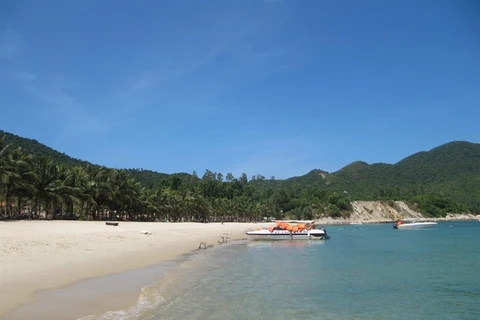 A boat docks on a beach off the Cham Islands. The world biosphere reserve is vulnerable to mass tourism with overloaded boats and logistics demands. (Photo: VNA)
A boat docks on a beach off the Cham Islands. The world biosphere reserve is vulnerable to mass tourism with overloaded boats and logistics demands. (Photo: VNA) Quang Nam (VNS/VNA) - The Cham Islands off the coast of Hoi An have since 2015 limited the number of tourists permitted to 3,000 per day to protect the vulnerable world biosphere reserve site from being overrun by boats and waste, but the area is in crisis despite these efforts.
Leaders of the protected area have expressed reluctance to allow in more boats, but officials from neighbouring Da Nang said they will go ahead with a plan to add a new route to the islands.
Director of the Cham Islands-Hoi An Marine Protected Area (MPA) Centre Tran Thi Hong Thuy has advocated against allowing more tourists and boats from the neighbouring city of Da Nang.
In April, Da Nang released a plan to develop eight aquatic tourism services – including a direct boat route from the Han River to the Cham Islands – by 2021.
However, the islands are already overloaded, with a fleet of 152 boats including 145 speed boats travelling between Cua Dai Port in Hoi An and the Islands (a distance of 20km).
“The Cham Islands are not only a tourism attraction, but also a world biosphere reserve,” Thuy said. “They need a balance between tourism development and nature conservation.”
“Da Nang and Hoi An have had discussions about the plan to operate more boats to the Cham Islands,” Thuy said. “However, the islands hold biodiversity conservation and sustainable development as their top priorities rather than mass tourism.”
The islands, which were recognised as a World Biosphere Reserve on over 33,000ha by UNESCO in 2009, hosted 21,000 tourists on the public holidays from April 27 to May 1 – an average of 4,200 visitors, far exceeding the daily limit.
In the first three months of this year, they hosted 54,000 visitors, a 69 per cent increase over the same period last year. The increase has stretched the food and fresh water supply – already a worry for the islands’ 2,400 residents – and put a strain on waste treatment services.
Vice Chairman of the People’s Committee of Tan Hiep commune in the centre of the islands, Mai Quoc Bao, said the 80,000cu.m reservoir on the islands could only supply enough fresh water for residents, and the rising number of tourists meant there was not enough water for locals during the high season.
Tourism has also had severe ecological impacts. At a conference on conservation of the islands, Thuy said 66 percent of the area’s sea grass was destroyed from 2009 to 2018, leaving just 17ha intact.
The damage was caused by the rapid increase of speed boats and fishing vessels over the past decade.
“The excessive number of speed boats has caused mass damage over a large area of sea grass off the islands and also destroyed safe shelter for marine species and fish,” Thuy said.
“Despite increasing the entrance fee from 30,000-70,000 VND in 2015 and imposing the daily limit, the Cham Islands are barrelling towards an environmental tragedy in the next three or four years,” Bao said.
Vice Chairman of the Hoi An People’s Committee Nguyen Van Son said that in the spirit of maintaining conservation as the top priority, the islands would reject the development of large-scale hotel and resort projects.
Tran La Tra, an expert from German development agency GIZ, said the Cham Islands offered tourism services at prices that were far too low.
“The islands have been seen as an ideal site with unique nature and status of a world biosphere reserve,” he said. “It is a challenge to balance conservation with tourism revenue.”
“The Cham Islands need more investment in nature conservation with safe and hospitable tourism services,” Tra said. “The islands should only offer tourism products and services that do not damage marine and forest biodiversity.”
According to a report from the MPA, the biosphere reserve has 1,500ha of tropical forests and 6,700ha of sea featuring a wide range of marine fauna and flora.
Bui Thi Thu Hien from the International Union for Nature Conservation (IUCN) said the islands only have strict protection requirements for a core zone of 1 percent of their total area. Hiền said the protection area should cover at least 30 percent.
Le Xuan Ai, an expert from the Cham Islands MPA, said beaches on the islands have been reserved for turtle conservation since the island started a hatching programme on Bac Beach in 2017.
Ai said human activities such as fishing and construction have seriously damaged the area’s seaweed and coral reefs, which shelter abundant aquatic species, and that allowing in more boats would only make the problems worse.-VNS/VNA
VNA
























